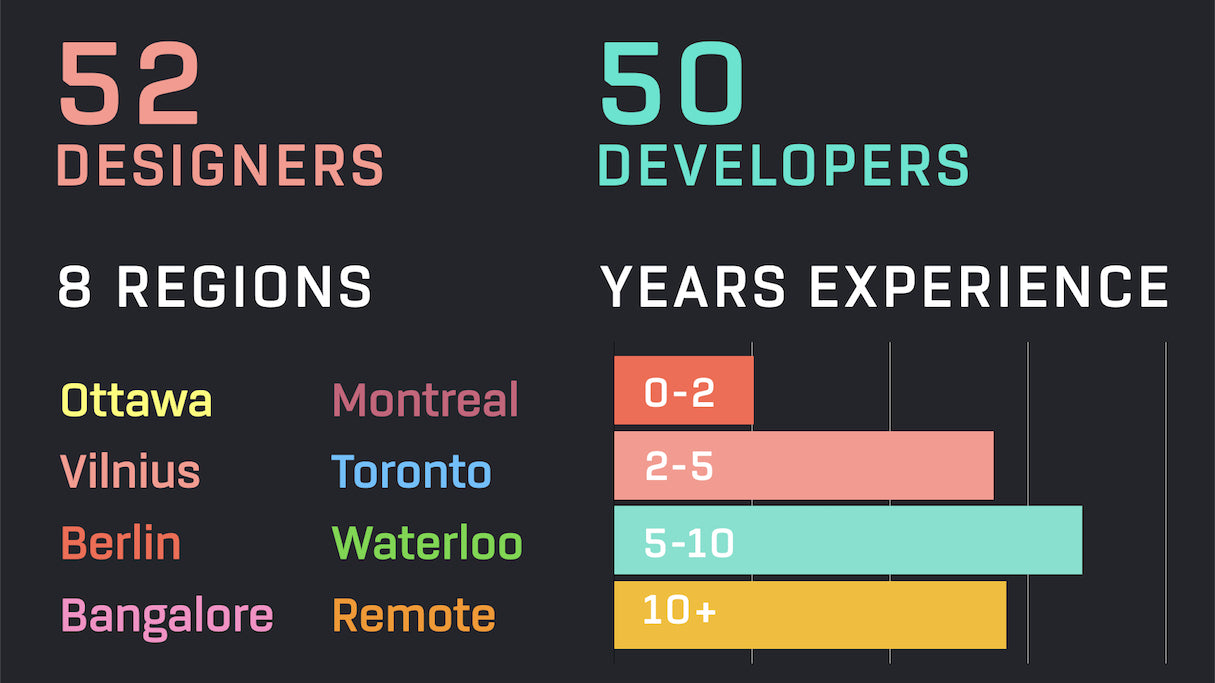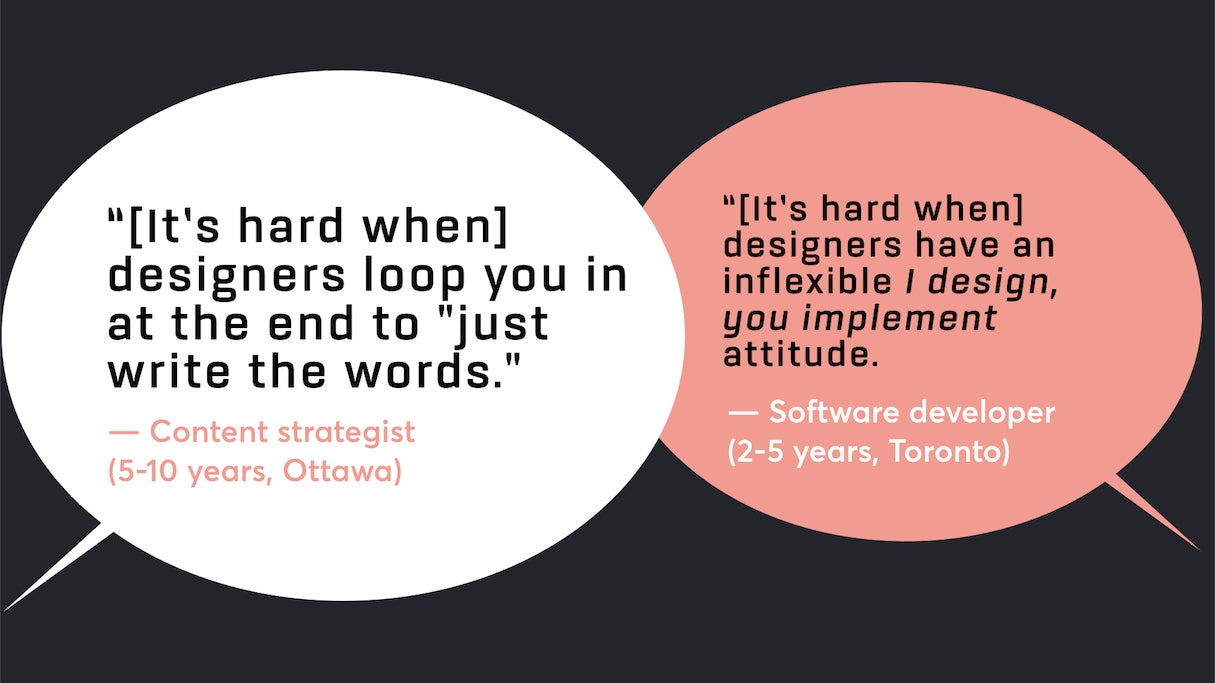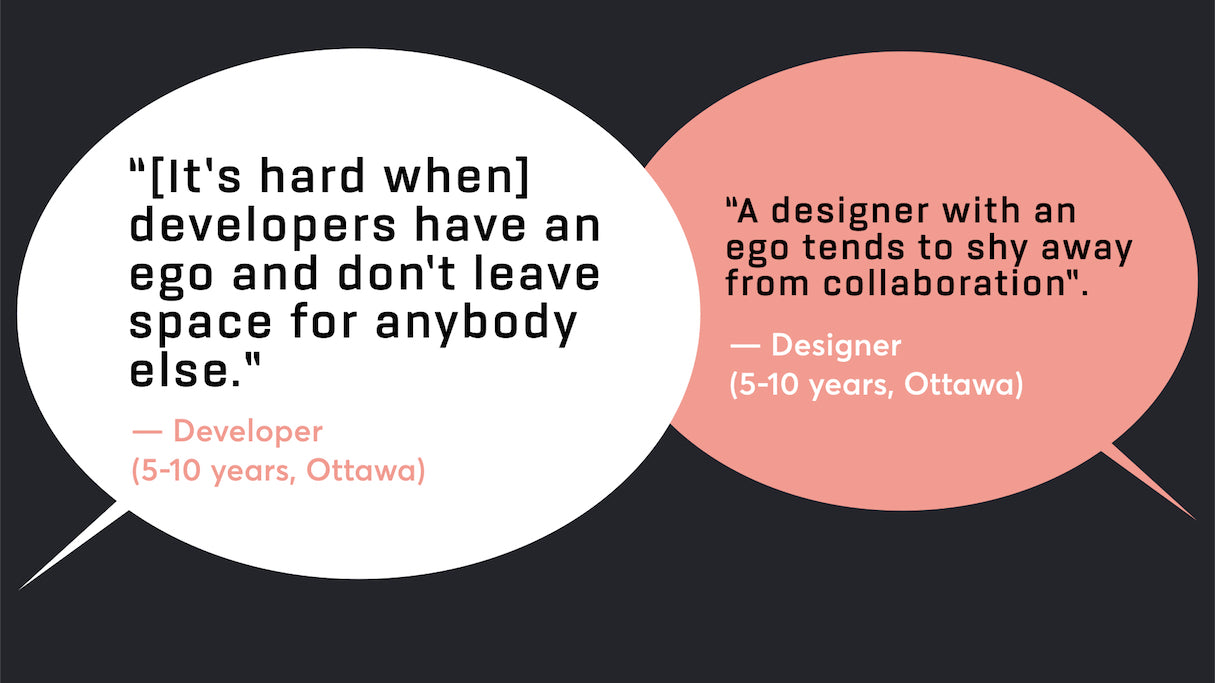What are the habits of great designers and developers? What makes for a strong, efficient design and development team? And how can you build an empowering culture in your own team?
To answer these questions, we decided to talk to our own teams here at Shopify, to try and learn what empowers individuals to increase their impact and build stronger relationships across disciplines. And we learned a lot. Read on for our findings on the secret to building strong teams.
The survey

Over 100 of our coworkers, including 52 designers and 50 developers, responded to our survey. We received responses from people at all levels including interns, juniors, crafters, seniors, leads (or ‘managers’), and directors. About 60 percent of all respondents had five or more years of experience in their craft.
In terms of geographic region, over 50 percent of the respondents worked in the Shopify headquarters in Ottawa (that’s where we work, so we naturally reached out to our closest colleagues first), with the remainder being evenly distributed among the rest of Shopify’s offices in eight different cities: Bangalore, Berlin, Montreal, Remote, Toronto, Vilnius, and Waterloo.

The results
As is every researcher’s dream, a common pattern emerged from crafters in both disciplines. Turns out there is one core skill set that commonly defines great designers and developers—giving and receiving feedback.
The theme of receiving feedback was reinforced by the high use of specific keywords throughout the survey. For example, “feedback” was the most frequently repeated word in the entire survey (not counting expected words like “design” and “developer”) with 72 mentions. Similarly, the ability to stay open to diverse perspectives was referenced about 57 times, empathy and ego each came up 20 times, and flexible attitudes surfaced in about 14 comments.
This was an overwhelming trend with a surprising caveat—instead of focusing on giving feedback, almost everyone referred to the ability to effectively receive feedback.
Almost all 100+ respondents identified the ability to receive feedback—in the form of newideas, questions, or critique—as the distinguishing trait that makes both designers and developers great to work with. Conversely, the inability to receive feedback was described as a serious pain-point for collaboration. We were surprised to discover that this sentiment was equally true in responses from both disciplines, and was referenced in terms of working with peers (eg. designers working with other designers), and across disciplines (eg. developers working with designers).
The art of receiving feedback includes the ability to accept criticism with an open mind, stay receptive to new and potentially conflicting ideas, and being flexible enough to pivot when limitations or success criteria change. Our survey showed that the ability to receive feedback can surface as a challenge during formal processes such as code reviews, design reviews, and in the day-to-day habits of collaborating across disciplines.
The responses also match up with our own experience working on multiple different teams. Generally speaking, people’s ability to receive feedback surfaces when teammates of either discipline offer feedback—either on design decisions, or when discussing workarounds for technical blocks during the build phase.
In the words of one lead developer from Montreal, “It’s difficult working with designers if they aren’t collaborative, and create designs without interacting with the people implementing the designs.”
A senior designer from Waterloo shared a similar sentiment. “Being a good communicator, even if it’s communicating that they're stuck, goes a LONG way in terms of being great to work with.”

From our personal experiences, and these survey responses, the greatest teams create spaces where designers and developers can openly share and receive feedback. So how can you build a team culture that encourages individuals to give, and receive, feedback across disciplines?
You might also like: How to Give Good Creative Feedback.
1. Collaborate often to create space for feedback
Creating space for feedback is all about maximizing the time spent collaborating within and across disciplines. This can happen in person or remotely via online chats or messages. The critical point is that there are regular opportunities for designers and developers to offer and receive feedback throughout both the design and development process.
Creating space for feedback requires change from individuals. Specifically, designers need to invite developers into their process—and vice versa. As uncomfortable as it might be to share a half-baked idea, or work that’s still in-progress, this transparency is at the root of highly aligned and efficient teams. It’s empowering to learn about the process of other disciplines, and offers opportunities to improve how teammates work together to build top quality products.
A senior designer in Montreal described an optimal team workflow nicely. “A collaborative environment, where the developer contributes to problem solving and is able to provide early input, and where the designer contributes to building and stress testing the solution, empowers both parties and always results in a better outcome.”
This sentiment was echoed by a senior design lead in Ottawa. “Working with a developer helps prove design ideas, and with early collaboration, it mitigates pitfalls and solutions that may not be favorable.”
This kind of early cross-disciplinary collaboration is helpful for developers, too. “When building UI components, I find it super helpful to have the designer in close proximity,” said a front end developer in their survey. “Any quick questions or quick feedback on something really speeds up the process.”
“When building UI components, I find it super helpful to have the designer in close proximity.”
These insights from our colleagues match up with our own day-to-day experience. Keeping the designers and developers on our teams highly informed throughout a process lifecycle allows for rapid feedback that always results in a better end product. Teams that are comfortable giving and receiving feedback often, also tend to be more comfortable challenging each other in healthy debate. These are the conditions that allow great minds, with diverse perspectives, to brainstorm and create innovative solutions to seriously complex problems. In other words, these are the conditions that set both individuals, and their teams, up for success.
How to create space for feedback
Below are a few ways that you can create spaces for feedback between designers and developers:
- Designers can invite developers to give feedback early in the design process to prevent wasted design time on a concept that may be technically infeasible.
- Developers can invite designers to give feedback when implementing. This helps ensure you’re aligned to the same end-goal, and can end up saving loads of time wasted due to miscommunication.
- Teams should book recurring meetings where everyone can meet to evaluate their progress, ask questions across disciplines, and give feedback to each other about how to improve quality or move faster.
- Weekly standups in person or online (eg. via Slack), where designers and developers update each other on what they’re working on, and anything blocking progress, can help make the process more transparent, open, and efficient.
These approaches work for many types of projects. If your team has a more Agile process, it can make each sprint more efficient. If your team uses a longer Waterfall-style approach, it can mean the difference between a slightly extended design phase and a completely wasted one.
2. Cultivate an open-minded work culture
From the survey responses, the most common complaint about working with either developers or designers was when people were closed to new ideas and therefore resistant to change. This surfaced as teammates’ inability to receive feedback due to a fixed mindset or closed attitude.
For example, one developer in Ottawa lamented the difficulty of working with teammates who have an ego and resist alternative solutions. This closed-minded attitude often seems to surface as defensive reactions to feedback, or designers and developers being protective of their code or design decisions.
At best, a close-minded reaction creates frustration between colleagues, which leads to an inefficient and demoralizing experience working on a project. At worst, it erodes trust, which can negatively impact the quality of the final product by preventing great ideas from being shared and built.

Why people have a closed mindset
A few respondents attempted to identify the reasons why designers and developers can harbor resistance to new ideas and changes. In the words of one design lead, collaboration across disciplines becomes difficult when people have an ‘us versus them’ attitude.
“If, for whatever reason, developers or designers are under the impression that we aren't on the same team, and aren't aligned on our shared goals, collaboration gets difficult. That tends to result in feedback being seen as threatening, and can make collaboration more combative.”
This combative reaction was also described as designers and developers reacting to feedback defensively, seeing it as a personal challenge or attack. Generally speaking, working with closed-minded individuals makes collaboration feel dramatic and frustrating, instead of efficient and empowering.
Building a growth mindset
What’s the solution to a pervasively defensive and closed-minded team culture? Our survey respondents identified that teammates with an open, accepting attitude were the very best to work with. Specifically, excellent developers and designers cultivate a growth mindset, practice the art of giving and receiving feedback, and prioritize building trust with teammates by staying open to new ideas. That means building off each others’ ideas, constantly adapting and improving their work, and staying open-minded to new ideas.
That means building off each others’ ideas, constantly adapting and improving their work, and staying open-minded to new ideas.
"An environment that encourages feedback across disciplines creates the foundation for the brightest, most innovative, and most impactful teams."
Furthermore, outstanding designers and developers go beyond practicing their own receptive responses. In the words of a senior product designer, great designers and developers are also able to create an environment where everyone can express their opinions. In other words, the best coworkers in either discipline are those who can create a culture where everyone feels comfortable engaging in healthy debate and fighting for the best ideas.
In our own experience, we’ve seen that an environment that encourages feedback across disciplines creates the foundation for the brightest, most innovative, and most impactful teams.
Since giving and receiving feedback is so important, we’ve found some resources to help improve these skills. Below are some of them.:
- We consider the book Radical Candor by Kim Scott our manual on giving feedback and supporting teammates
- At Shopify, we’re all encouraged to learn about growth mindsets by reading and sharing the book Mindset: The New Psychology of Success by Carol S. Dweck
- Giving feedback can be an uncomfortable experience, but Crucial Conversations: Tools for Talking When Stakes Are High by Kerry Patterson, Joseph Grenny, Ron McMillan, Al Switzler and Stephen R. Covey offers practical strategies to tackle difficult situations
You might also like: Should Your Agency Adopt an Agile Process?
3. Only offer specific, tangible, and actionable feedback
Staying open to receiving feedback is only half the battle, because not all feedback is created equal. Have you ever heard the saying that feedback is a gift? In reality only clear and precise feedback is a gift, because only clarity and precision have the power to inspire change or create new opportunities for growth.
The survey results highlighted the importance of giving precise feedback that’s also actionable. This can help shift someone’s reaction from defensiveness to receptiveness. If you’re able to help unblock someone or support their growth through feedback, they will thank you for it in the end.
"Only clear and precise feedback is a gift, because only clarity and precision have the power to inspire change or create new opportunities for growth."
How to respond to vague feedback
Because specific feedback is so important, you should not only receive feedback on projects, but on your feedback itself. Rather than viewing feedback as a one-way street, great teammates learn to respond to vague feedback in a way that improves the quality of the initial feedback being given.
For example, a coworker or lead might offer someone vague feedback by saying, “You’re doing a great job,” or, “Just keep practicing and you’ll improve.” In this scenario, there’s an opportunity for the recipient to challenge for more details.
Some questions the recipient of vague feedback could ask are:
- Can you give me examples of what I’ve been doing well? What impact did that have on the project or on the team?
- What went well in this project, and why?
- What skills are important for me to prioritize to continue to grow to the next level of impact?
Simply put, everyone wins when the receiver of feedback feels empowered to ask questions and expand on the feedback they’ve received. By challenging for more precision—in the form of examples or specific details—anyone can extract value from feedback that starts off as vague or unclear.
and expand on the feedback they’ve received. By challenging for more precision—in the form of examples or specific details—anyone can extract value from feedback that starts off as vague or unclear.
You might also like: 12 Rules of Engagement When Running Design Critiques from NASDAQ’s Aaron Irizarry.
Great designers and developers care about feedback
In the end, this survey taught us that there are three key mechanisms for building excellent teams, and embedded in each of these are actionable steps that anyone can use to become an effective teammate. These steps are:
- Create spaces for a healthy cycle of feedback. This can happen in casual settings like whiteboarding in pairs, or during more formal processes such as design and code reviews.
- Advocate for the art of receiving feedback. This means learning how to keep your own defensive reactions in check, and encouraging teammates to share new ideas and engage in healthy debate.
- Practice the art of giving specific feedback on a regular basis. Be mindful about offering precise feedback with specific examples.
These habits are at the core of excellent teams, and practicing sharing feedback regularly is a tangible way for anyone to increase their individual value within their team. Using these strategies empowers teams to work faster and create better quality solutions.
These habits and systems of giving and receiving feedback are at the core of excellent teams. The result benefits the individual, the team, and from a business perspective, enhances the overall quality of the final outcome. This is because teams that are highly collaborative tend to be more aligned, are faster to adapt to new obstacles, and are more able to leverage their diverse skill sets to produce truly innovative solutions. If you’re looking to grow your team, and ultimately to improve your business, this is a great place to start.
The result benefits the individual, the team, and from a business perspective, enhances the overall quality of the final outcome. This is because teams that are highly collaborative tend to be more aligned, are faster to adapt to new obstacles, and are more able to leverage their diverse skill sets to produce truly innovative solutions. If you’re looking to grow your team, and ultimately to improve your business, this is a great place to start.
Read more
How do you create space for feedback at your business? Let us know in the comments below!

